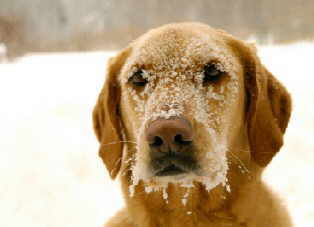
Frostbite takes paws of cat
By: Tanya Stroman
Many times, particularly in the south, we will coop ourselves and our pets in the house to avoid any dangers during this time. But don’t let the weather control the exercise and quality time your pets should be enjoying.
I am no way saying that your pets should be locked outside . Yes , in my opinion that’s abuse. But our pets aren’t feeble beings and there are ways for them to enjoy themselves during the winter months with creativity and safety precautions in use.
Winter has the benefit of being a great time to enjoy fresh air and exercise. I am going to provide you with precautions for you and your pet to keep safe during this time. Here is a top list of advice to help your pets cope with winter weather.
1) One misconception among people is that cats and dogs can withstand coldtemperatures simply because they have fur. Let’s straighten this out now, while it’s true that some large dog breeds are well equipped for the cold weather, others are more sensitive. Provide your fair-weathered pets with a coat and boots.
2) I am not a believer in keeping my cats outdoors. That’s for several reasons. Yet I do understand some owners don’t mind their cats outside for a couple of hours. Know this, cats usually don’t stay outdoors for long when it’s very cold. Yes their temperament for cold is the same as ours. They will protect themselves from cold weather so help them. Always check the upcoming forecast before letting your cat out. If you are not going to be home to let your cat back into the house, don’t let it out.
A list of winter-related conditions to watch out for in your pet:
Frostbite
When animals are exposed to freezing temperatures for an extended period, they are vulnerable to frostbite on their extremities, including ear tips, foot pads and belly. When a dog or cat is exposed to cold temperatures, its body reacts in stages:
1) Your pet’s fur provides insulation just like us when wearing a coat. Their hairs, when exposed to cold air, undergo pilo-erection. This is like you and I getting goose bumps. The hairs “stand up” trapping the air in that layer. This air is warmed by the body and adds additional insulation.
2) When the body’s core temperature decreases, an involuntary reflex by the skeletal muscles known as “shivering” is triggered to generate heat and warm you up. Animals, like humans, experience this same reaction.
3) When the body is really getting cold and the animal’s life may be at risk, the body responds by vasoconstricting the peripheral tissues. This means the body is being selective in where it is sending warm blood.
The organs are the most important to keep both an animal and human alive so that blood is circulating in the core of the body (heart, liver, kidney lungs,) and shuts down temporally by constricting blood vessels to the extremities until the body’s normal temperature is attained.
4) If a cat or dog is still exposed to the cold by this stage, frostbite will develop. In extreme cases, frostbite can mean the loss of limbs, toes and ear tips.
If you suspect your animal is suffering from frostbite, start administering first aid immediately to avoid permanent damage. Please ensure you seek veterinary assistance as frostbite can be dangerous if left untreated.
Here are some first aid tips to keep your pet safe:
1) Warm the affected area slowly with warm water using towels.
2) If it is a limb or paw that is frozen, soak it only in a bath or bowl of warm water
3) Dry gently after you have the warmed the area
4) Do not rub or massage the frozen tissue.
5) Do not apply snow or ice.
6) Do not immerse your pet completely in a bath this will cause the body temperature to decrease and cause hypothermia.
Hypothermia
Make sure that frostbite is treated. If frostbite goes untreated, hypothermia can develop. Hypothermia is an abnormal lowering of the body’s temperature. This is a serious condition that can cause unconsciousness, shock and even the death of a pet. Be careful, however, as frostbite alone is not a guaranteed precursor to hypothermia.
If you suspect hypothermia, it is best to seek medical treatment from your veterinarian as this condition can worsen without proper care. While they are being transported to the veterinarian there are a number of methods you can use to stabilize your pet :
1) Warm your pet slowly using blankets
2) Put warm water in plastic bottles then wrap in towels to prevent burns.
3) Use plastic zip lock bags filled with uncooked rice that you warm in the microwave for 1-2 minutes then wrap in a towel.
Conclusion
• Provide winter footwear for pets – they may squirm and make a fuss at first, but their paws will thank you!
• Avoid too much walking on salt – wipe your pet’s feet!
• Don’t leave pets in the car during cold weather
• Keep pets away from the fireplace
By: Tanya Stroman
Many times, particularly in the south, we will coop ourselves and our pets in the house to avoid any dangers during this time. But don’t let the weather control the exercise and quality time your pets should be enjoying.
I am no way saying that your pets should be locked outside . Yes , in my opinion that’s abuse. But our pets aren’t feeble beings and there are ways for them to enjoy themselves during the winter months with creativity and safety precautions in use.
Winter has the benefit of being a great time to enjoy fresh air and exercise. I am going to provide you with precautions for you and your pet to keep safe during this time. Here is a top list of advice to help your pets cope with winter weather.
1) One misconception among people is that cats and dogs can withstand coldtemperatures simply because they have fur. Let’s straighten this out now, while it’s true that some large dog breeds are well equipped for the cold weather, others are more sensitive. Provide your fair-weathered pets with a coat and boots.
2) I am not a believer in keeping my cats outdoors. That’s for several reasons. Yet I do understand some owners don’t mind their cats outside for a couple of hours. Know this, cats usually don’t stay outdoors for long when it’s very cold. Yes their temperament for cold is the same as ours. They will protect themselves from cold weather so help them. Always check the upcoming forecast before letting your cat out. If you are not going to be home to let your cat back into the house, don’t let it out.
A list of winter-related conditions to watch out for in your pet:
Frostbite
When animals are exposed to freezing temperatures for an extended period, they are vulnerable to frostbite on their extremities, including ear tips, foot pads and belly. When a dog or cat is exposed to cold temperatures, its body reacts in stages:
1) Your pet’s fur provides insulation just like us when wearing a coat. Their hairs, when exposed to cold air, undergo pilo-erection. This is like you and I getting goose bumps. The hairs “stand up” trapping the air in that layer. This air is warmed by the body and adds additional insulation.
2) When the body’s core temperature decreases, an involuntary reflex by the skeletal muscles known as “shivering” is triggered to generate heat and warm you up. Animals, like humans, experience this same reaction.
3) When the body is really getting cold and the animal’s life may be at risk, the body responds by vasoconstricting the peripheral tissues. This means the body is being selective in where it is sending warm blood.
The organs are the most important to keep both an animal and human alive so that blood is circulating in the core of the body (heart, liver, kidney lungs,) and shuts down temporally by constricting blood vessels to the extremities until the body’s normal temperature is attained.
4) If a cat or dog is still exposed to the cold by this stage, frostbite will develop. In extreme cases, frostbite can mean the loss of limbs, toes and ear tips.
If you suspect your animal is suffering from frostbite, start administering first aid immediately to avoid permanent damage. Please ensure you seek veterinary assistance as frostbite can be dangerous if left untreated.
Here are some first aid tips to keep your pet safe:
1) Warm the affected area slowly with warm water using towels.
2) If it is a limb or paw that is frozen, soak it only in a bath or bowl of warm water
3) Dry gently after you have the warmed the area
4) Do not rub or massage the frozen tissue.
5) Do not apply snow or ice.
6) Do not immerse your pet completely in a bath this will cause the body temperature to decrease and cause hypothermia.
Hypothermia
Make sure that frostbite is treated. If frostbite goes untreated, hypothermia can develop. Hypothermia is an abnormal lowering of the body’s temperature. This is a serious condition that can cause unconsciousness, shock and even the death of a pet. Be careful, however, as frostbite alone is not a guaranteed precursor to hypothermia.
If you suspect hypothermia, it is best to seek medical treatment from your veterinarian as this condition can worsen without proper care. While they are being transported to the veterinarian there are a number of methods you can use to stabilize your pet :
1) Warm your pet slowly using blankets
2) Put warm water in plastic bottles then wrap in towels to prevent burns.
3) Use plastic zip lock bags filled with uncooked rice that you warm in the microwave for 1-2 minutes then wrap in a towel.
Conclusion
• Provide winter footwear for pets – they may squirm and make a fuss at first, but their paws will thank you!
• Avoid too much walking on salt – wipe your pet’s feet!
• Don’t leave pets in the car during cold weather
• Keep pets away from the fireplace


 RSS Feed
RSS Feed